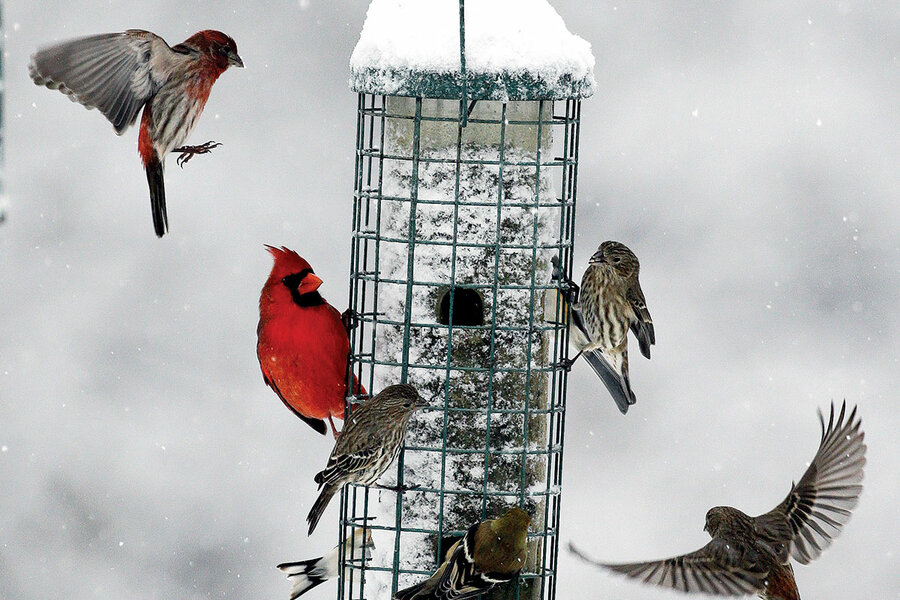
It was 19 below zero in my corner of Maine. Myriad birds flitted about my feeder. Only an inch of seed remained, a scarcity that incited a frenzy. Chickadees, nuthatches, juncos, goldfinches, and cardinals – I shivered for them. Must I go out and replenish the feeder? A feeder is a kind of compact: I’ll feed you, if you’ll display your beauty and antics.
My hand was forced when a bluebird banged into the window. It lay in the snow, motionless. I donned parka, scarf, hat, boots, and gloves. The air was sharp as flint. I pushed through knee-deep drifts.
Why We Wrote This
Surviving winter can feel like a solitary affair. But our essayist finds delight in maintaining his bird feeder. On one frigid day, the chore proves unexpectedly life-giving.
Carefully, I picked up the bluebird, cupping it in my hands. I blew warm air on it while the wind howled. Finally, the creature gave a vigorous flutter. I opened my hands and off it flew.
I grabbed the feeder and filled it to brimming. I held it aloft like a beacon of hope as I returned.
And then – a small wonder. As I reached up to replace the feeder, a chickadee landed on my shoulder and emitted a chitter of anticipation. I froze, and the bird hopped onto the feeder. I watched as other birds arrived. Cold or no cold, they had a job to do.
As did I.
Yesterday the temperature bottomed out at 19 below zero here in my corner of Maine. As I stood at the kitchen window, peering out at the frozen landscape, I watched as myriad birds flitted about the feeder. There was only about an inch of black oil sunflower seed remaining in the long plastic tube, and it was this scarcity that seemed to incite them to a frenzy of competition for the last grains.
Chickadees, nuthatches, juncos, house finches, goldfinches, and cardinals: As hardy as these species are, I still shivered for them as I watched their desperate bids for food in the biting cold.
My dilemma: Do I go out there to replenish the feeder or not? In addition to the cold, the snow was knee-deep. But I was snug inside with a cup of steaming tea in my hands. I was mindful of guidance from those in the know that once one starts to feed birds one must keep it up, especially during the winter when wild food is hard to come by. In essence, a feeder is a kind of compact: Yes, I’ll feed you if you simply continue to put your beauty and your antics on display.
Why We Wrote This
Surviving winter can feel like a solitary affair. But our essayist finds delight in maintaining his bird feeder. On one frigid day, the chore proves unexpectedly life-giving.
When it comes to beauty, there are some stunning specimens, even at this latitude. I’ve already mentioned the cardinal, strikingly red against the snow. Another bird sporting a bright primary color is the blue jay. Then there is the rose-breasted grosbeak with its scarlet bib, the black-and-white checkerboard of the downy woodpecker, the buff and yellow of the cedar waxwing, and the subtler hues of the bluebird, said to be migrating farther north as global warming proceeds.
As for antics, they are abundant as well. Other birds seem to be aware of the cardinal’s majesty and unfussingly defer to it when it alights. The blue jay, on the other hand, blows into town like a Wild West gunslinger entering a saloon – everybody scatters. The chickadee – Maine’s state bird – is both acrobatic and tame: With patience it can be trained to eat from one’s hand. What could be more enchanting than that?
Which brings me back to my dilemma: to venture out or not? My hand was forced when a bluebird, flying from the feeder, banged into the window. I pressed my nose to the glass and saw it there, in the snow, the frigid wind fluffing its feathers as it sat motionless.
That was it, then. I commenced the Maine cold-weather ritual of donning parka, scarf, knit hat, boots, and gloves. I opened the door and the air – sharp as flint – took my breath away. Pushing my way through the snow, I tripped over the drifts, all the while asking myself, how do they do it? How do birds and other animals survive this cold?
The bluebird was still on the ground. I carefully picked it up and cupped it in my hands, blowing warm air on it while the wind howled about us. Finally, the creature gave a vigorous flutter. I opened my hands and off it flew.
Grabbing the feeder, I retraced my steps to the mother lode of seed kept under wraps on the back porch. I filled it to brimming, drew in a breath, and set out again, through the drifts, through the wind, tripping only once this time as I held the feeder aloft like a beacon of hope and promise.
And then – a small wonder. Just as I was reaching up to hook the feeder in place, a chickadee landed on my shoulder and emitted a chitter of anticipation. I was so taken by this that I froze in mid-reach, willing to endure the cold wind for the sake of protracting the moment. I hung the feeder and the chickadee hopped onto it to stake its claim. Stepping back, I watched as other birds arrived. Cold or no cold, they had a job to do.
As did I.
